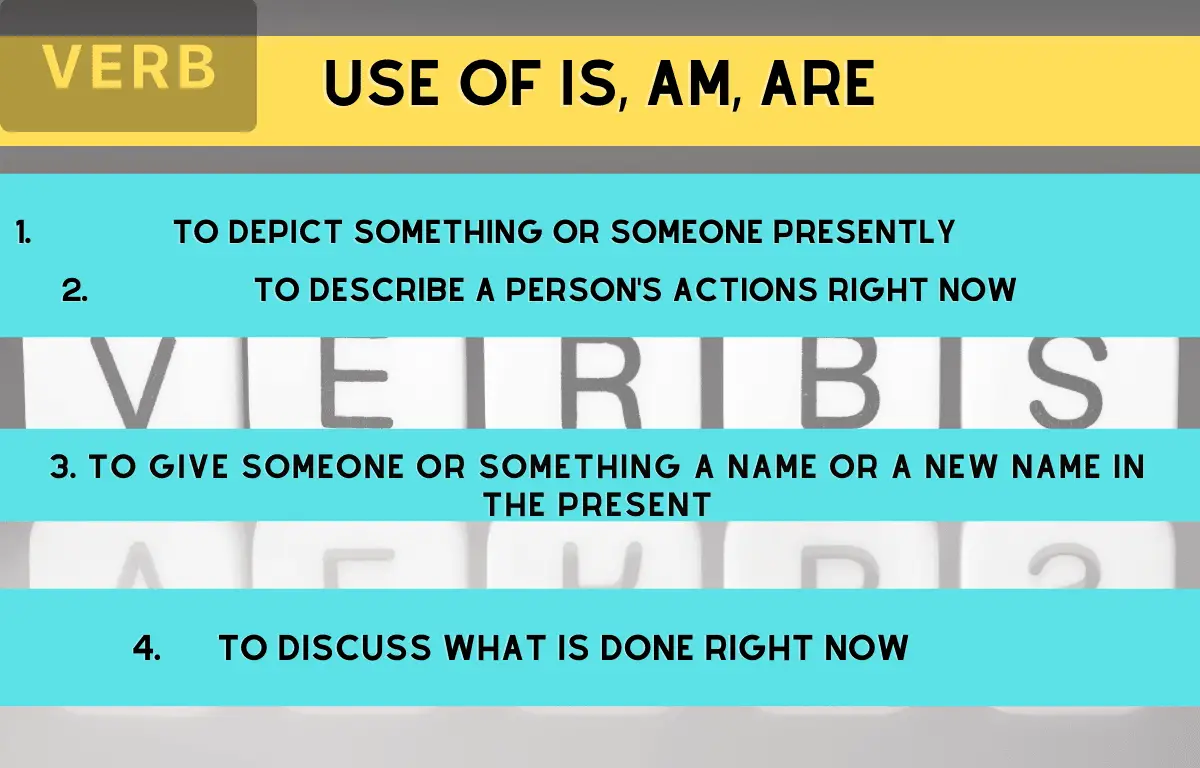The most common helping and primary verbs in English are IS, AM, and ARE. We will learn how to use the English words is, am, and are Sentences in English in this post.
We apply the verbs IS, AM, and ARE in the present tense in four diverse situations.
- To depict something or someone presently
- To give someone or something a name or a new name in the present
- To describe a person’s actions right now
- To discuss what is done right now
Let’s look at the nouns or pronouns we employ with is, am, & are before examining these instances individually.
IS is for “he, she, it,” & all singular noun names (singular subject), and “ARE” stands for “we, you, they,” and all plural noun names (plural subject).
AM is only used with “I,”
Singilar Countable Nouns: Muaz, Manha, Jyoti, a doctor, a singer, a mother, a car, a bus, a table, etc. are all singular countable nouns.
Plural Nouns Names: Students, parents, teachers, siblings, brothers, automobiles, trucks, tables, and other plural noun names
- To express something or someone in the present
Use the verbs of is, am, and are that correspond to the subject when explaining someone or something in the present.
A few “AM” examples
I’m a genius.
She is gifted.
I’m glad.
I’m so depressed.
I’m serious.
I am regretful.
Note: A word that is highlighted in red is an adjective or an adjective phrase.
I’m glad you got a promotion.
This makes me sad to watch.
I’m focussing on the game.
My condolences for your loss.
‘IS’ examples
She is stunning.
He is skillful
Jyoti has a great deal of artistic talent.
My dad is a bit of fun.
It’s a big house.
She has a little dog.
NOTE: This is the first time that the words “is,” “am,” and “are” are used to denote the subject in the present tense following an adjective or an adjective phrase.
- To give someone or something a new name in the present
The second function of the verbs is, am, and are is to rename a subject (noun or pronoun) in the present. Here, we name the subject by adding a noun or noun phrase after is/am/are.
Subject + is, am, or are + Noun
Instances of “is/are/are”
I am an educator.
You are my closest friend .
Manha is an artist.
I educate English students.
We are learners.
They are cousins of mine.
He is one of my close friends.
My girlfriend is her.
It is a fantastic film.
Monu is a wonderful friend.
My parents work in education.
They work in social services.
Rahul performs dance.
Jon competes in MMA.
Keep in mind that we are naming the subject in the present by employing a noun or a noun phrase following is/are/are.
- To describe a person’s current activities
The third way to utilize “is, am, are” is to communicate about a present-tense activity by using the Present Continuous tense. These verbs serve as connecting verbs (main verbs) in the first two instances while serving as an auxiliary verb in this context (helping verb).
Subject plus is/am/are + V1 +ing
Instances of “is/am/are”
I am speaking with you.
This post is being viewed by you.
We are making a project.
They are making fun of you.
Manha is living with me. (Manha resides in my home).
He is having fun outside.
It is not operating correctly.
In her room, Manha is painting a stone.
Speaking to his mother is Archit.
They are watching television.
Outside, some kids are having fun.
Note that we also use the verbs “is,” “am,” and “are” to refer to impending or scheduled events.
We’re about to embark on a vacation.
They’ll arrive tomorrow.
Next week, Shruti will enroll in the online course.
- To discuss what is being done right now
The last time “is, am are” was used, it was to discuss current events. The present indefinite tense passive voice is used in this sentence.
Arrangement: Subject + is/am + V3 + (by the doer)
So, these are the four applications of is, am, and are. Use the practice questions below to assess how well you comprehend the subject.
Examples:
He gets paid on schedule by the business.
He receives his payment on time in the present tense, active voice (by the company). (Passive voice, present indefinite tense)
Everyone respects the work I do.
I receive praise for my job (active voice, present indefinite tense). (Passive voice, present indefinite tense)
We give the students excellent instruction. (Active voice, present indefinite tense)



